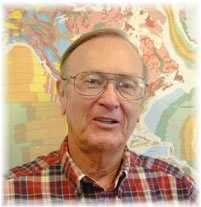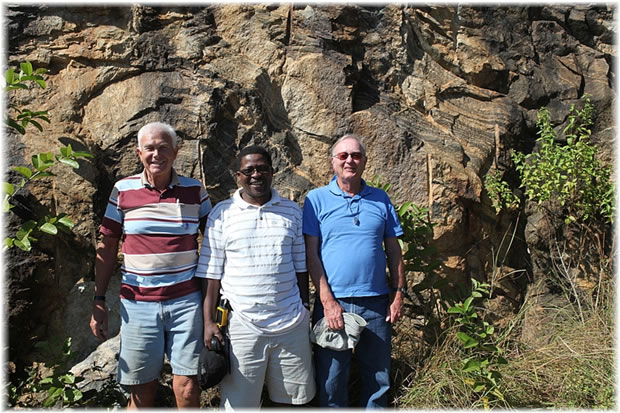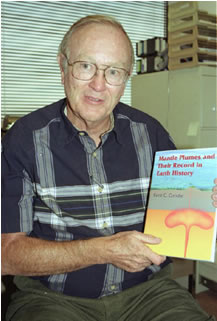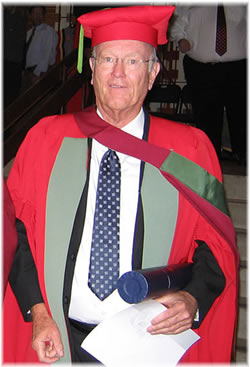Profiles of Notable New Mexico Geologists
Contents:

Kent Condie:
Born: November 28, 1936, Salt Lake City, Utah
Kent Condie is a professor of geochemistry at New Mexico Tech, where he has taught since 1970. His primary research focus, the origin of the continents, has taken him to observe billion-year-old rocks in remote locations around the globe. A prominent author, Kent Condie has written books and scientific articles that have become standard references in various field of geology, such as Plate Tectonics and Crustal Evolution and Earth as an Evolving Planetary System.
Kent Condie was born in Salt Lake City, Utah, on November 28, 1936. His interest in geology was sparked when he was working for a whitewater rafting guide on the Colorado River during college. “I got interested in the geology along the river,” he said.
In 1955, he enrolled at the geology program at the University of Utah, where he obtained his Bachelor of Science degree in 1959 and a Master’s degree in 1960.
In the fall of 1960, he enrolled in a PhD program at Scripps Institute of Oceanography at the University of California at San Diego. During this period, he had the opportunity to write a thesis on the origin of the moon with Nobel Laureate Harold Urey, which he later declined. He preferred to bang an outcrop with his own hammer and collect his own samples, something that was not possible if he chose to work on a lunar thesis.
He decided to work with Albert Engel, a geology professor at Scripps, who triggered Kent Condie’s interest in ancient rocks and their potential to reveal the early part of Earth's history. At Scripps, he also learned the value and challenge of precise chemical analysis from Rama Murthy. These geochemistry lessons he learned at this institution became valuable for him as he started his research.
In 1965, Kent Condie obtained his PhD with a thesis entitled “Petrology and geochemistry of the late Precambrian rocks of the northeastern Great Basin.” He moved to New Mexico in 1970 after teaching for six years at Washington University. “I like the West,” he said. Ever since, he has been doing a lot of research on historical geology in the areas of New Mexico and Colorado.
Kent Condie and his graduate students are involved in several studies related to plate tectonics and the crustal evolution. Or as he worded it, “My main research is to study the origin of continents.”
When plate tectonics began on planet Earth is one of the questions that he and his students have been trying to answer throughout their research. By studying several Archean (2.5 to 4 billion years of age) greenstone belts using geochemical indices, Kent Condie and his students are trying to define a tectonic setting constraint in which the greenstones formed. The result of this study will be valuable in understanding how and when the tectonic plates forming the Earth’s crust began to move
Kent Condie and his graduate students are also involved in detailed geochemical and isotopic studies of granitic rocks on both sides of the Archean/Proterozoic boundary in Colorado, Wyoming, Canada and elsewhere. At this time, they are trying to find fundamental changes in tectonic regimes by verifying geochemical differences across this boundary. .The conclusion of this research would be very important forthe study of planetary evolution.

Kent Condie’s research on the origin of continents eventually took him all over the world. He has visited most partsof Africa, Western Australia, Northern Europe, Siberia, and China. Most of his early work was carried out in Southern Africa, which he visited for the first time in June 1973.
With a research grant from the National Science Foundation, Kent Condie arrived in South Africa where he encountered outcrops of 3.5 billion-year-old greenstones. Greenstones are altered volcanic rocks which usual erupt on the ocean floor. “They are 3.5 billion years old, but they are well-preserved,” he said. These volcanic rocks contain answers to important questions about how Earth evolved and why it is so different from other planets like Venus and Mars. It is a great challenge for geologists to learn how to extract such information from outcrops of old rocks all around the globe.
His visit in Africa was full of unforgettable experiences which went beyond observing and collecting samples from rocks. One time, when he was sampling in a national park, Condie neglected a ranger’s advice to stay in the car because there were a group of elephants nearby. “I got out [of the car], hammering on the rocks, and I was not paying much attention to them. And then a big male elephant started to charge.”
Another time, he had to travel within a region suffering from horizontal conflict, where sandbags surrounded buildings and an exploded bus sat in the highway. However, these experiences did not stop him from being engrossed with the exotic continent, where much of the earliest part of Earth’s history is preserved.
Inspired by his findings in South Africa, Kent Condie saw the need for a textbook on the early part of Earth’s history. In 1976, he published his first book Plate Tectonics and Crustal Evolution. The book covers the subjects of plate tectonics, geochemistry, Earth’s evolution and even biological processes. Encouraged by the rapid acquisition of new scientific data, Condie has been keeping the book updated and it has gone until the fourth edition.
In the mid of 1990s, while conducting a study in the western Superior Province in Canada, Kent Condie discovered some unusual greenstones which had the composition of young oceanic plateau basalts, a product of mantle plume magmatism. This discovery led him to a deeper study with such greenstones in order to trace the role of mantle plumes in the geologic past.

Kent Condie displays his book Mantle Plumes and Their Record in Earth History
“Mantle plumes are big blobs of hot material that come up from the center of the earth,” he explained. Hawaii, Iceland, and Yellowstone are among the examples of mantle plume existence. The study of mantle plumes was accelerated by the availability of high-speed computers and increased precision of seismic tomography which allowed the mapping of Earth’s mantle. Data from exploration on Mars and Venus also showed how mantle plumes played a dominant role in the evolution of these planets instead of plate tectonics.
The abundance of published data on mantle plumes prompted Kent Condie to write a book on mantle plumes called Mantle Plumes and Their Record in Earth History, published in 2001. The book addresses various questions such as could the Earth have been more like Mars and Venus during the Archean age and how to identify the effects of mantle plumes in the geologic record. “We got a lot of scientific discussion over the years just to what mantle plumes could do and what mantle plumes couldn’t do,” he said.
Earth as an Evolving Planetary System, published in 2004, is another book which Kent Condie single-authored. In this book, Condie synthesizes data from the fields of oceanography, geophysics, planetology, and geochemistry to examine the key topics and questions relating to the evolution of the Earth's crust and mantle. The second edition of this book was published in 2011.
His bibliographical contribution toward the field of geology went on and on. Together with Robert Sloan, Kent Condie co-authored Origin and Evolution of Earth: Principles of Historical Geology which was published in 1998.He also became the editor for three books dedicated to the study of development in Precambrian geology. Archean Greenstone Belts, the first book he edited, was published in 1981 and then followed by Proterozoic Crustal Evolution(1992) and Archean Crustal Evolution(1994).He also contributed as the co-editor for an American Geophysical Union monograph, Archean Geodynamics and Environments(2006).
When asked how he gets the motivation to write his books, Kent Condie replied, “When you’re heavily involved in research and asking questions about how the Earth works, it’s not hard to write. You want to share your ideas with others, you see.”
Throughout his career, Kent Condie has written more than 150 papers which have been published top-rated Earth science journals. Three of his papers were published in American Journal of Science, two in Science and another one in Nature.The prominence of his works was reflected by two Most Cited Paper Awards he received for Supercontinents and superplume events: Distinguishing signals in the geologic record(2004) and TTGs and adakites: Are they both slab melts?(2005).

Kent Condie receiving Honorary Doctorate Award in U. of Pretoria (South Africa)
His astounding achievement and contribution in geoscience has been recognized by multiple institutions. In 1987, Kent Condie received a Distinguished Research Award from New Mexico Tech. Later on, he was awarded an Honorary Doctorate from the University of Praetoria in 2007 for his research and involvement with geoscientists in South Africa. The Principal of the Council that gave him the prestigious award addressed him as “a leading thinker and innovator in the greenstone belt studies, mantle plumes and superplumes.”
It has been forty years since he started teaching at New Mexico Tech and he is still showing his unquestionable dedication by giving lectures and guiding his students in their research. His books and publications have been used as a standard references for geoscientists. Yet, he keeps on working to help us understand how our Earth evolved into its current state.
When asked about his expectations about the future of geosciences, he said, “It is very hard to look ahead ten years and see where we are going to be.” He may not be sure about what geoscientists will discover in the future, but we can be sure that his works have helped pave the way to it.
— Ivan Kurnia
Sources:
-
Earth and Environmental Science Department(2011, 02 May). ‘Faculty-Condie’. New Mexico Tech. Retrieved April 25, 2013 from <http://www.ees.nmt.edu/teachingresearch-faculty/192-condie>
-
Earth and Environmental Science Department (2011, 03 May). ‘Condie-Doctorate Award’. New Mexico Tech. Retrieved April 25, 2013 from <http://www.ees.nmt.edu/teachingresearch-faculty/202-condiedoctorate>
Specialties:
Geochemistry, Historical Geology
Keywords:
Archean, Proterozoic, Precambrian, greenstone belts, crustal evolution